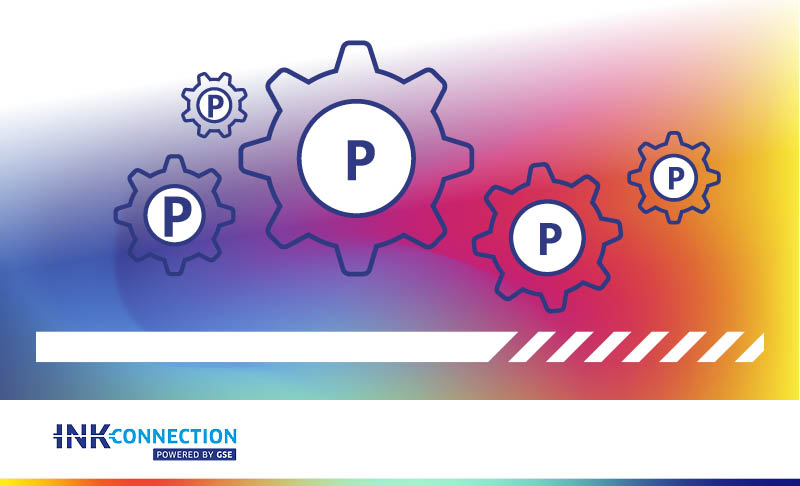Continuing our series on navigating ink-related food safety standards
We’re publishing dedicated blogs that explore each standard and explain how our ink management solutions can help you comply with them. See our previous blogs on housekeeping and cleaning, hazard analysis and risk management, record keeping, traceability and equipment maintenance.
Good Manufacturing Practices (GMP) are essential guidelines that ensure food packaging materials are produced safely and do not pose a risk of contamination to food products. In this blog, we’ll explore the GMP requirements set by GFSI-recognized schemes (BRCGS, SQF, and FSSC 22000).
GMP requirements in the three food safety management schemes
In our blog series on GFSI food safety standards, we have identified GMP as a distinct standard. However, in practice, GMP serves as a common thread running through all recognized food safety standards.
GMP focuses on five key elements (the “five P’s”): People, Premises, Processes, Products, and Procedures. In this blog, we will examine the ink-related issues of each of these elements, share best practices, and link to previous blogs that cover related standards. Additionally, we will highlight process control requirements that have not yet been discussed, specifically:
- Section 5.3 and 5.4 of the BRC Global Standard (BRCGS) for Packaging Materials
- Sections 1.9 of FSSC 22000 (Food Safety System Certification)
- Section 13.1 of Safe Quality Food (SQF).
People: proper training & handling
✅ Train employees on ink safety and migration risks
- Educate staff on how inks can migrate and the importance of using low-migration inks for food packaging.
- Conduct regular training on handling procedures, safety measures, and contamination prevention.
✅ Follow proper ink-handling procedures
- Use dedicated tools and protective equipment when handling inks to prevent cross-contamination.
- Ensure workers follow GMP hygiene protocols, such as wearing gloves and washing hands before working with packaging materials.
✅ Assess risks in printing and packaging processes
- Perform pre-press risk assessments to identify potential errors, such as missing print information or ink mixing issues.
- Establish clear approval procedures before starting any print run.
Premises: appropriate equipment, controlled storage & facility management
✅ Ensure equipment is clean, maintained, and appropriate for use:
- Document and implement equipment specifications and purchasing procedures to ensure suitability for packaging printing operations.
- Select, install, and operate equipment to allow thorough cleaning and prevent contamination risks.
- Use food-safe tools, utensils, and containers for handling inks and raw materials.
✅ Store inks in a dedicated, controlled environment
- Keep printing inks, adhesives, and coatings in temperature-controlled, well-ventilated areas to preserve quality.
- Use sealed storage areas to protect inks from dust, pests, and other contaminants.
✅ Maintain proper ventilation in printing areas
- Install ventilation systems to remove solvent fumes and airborne ink particles, ensuring both worker safety and print quality.
- Conduct regular air quality checks to comply with health and safety standards.
✅ Use proper lighting in inspection areas
- Equip print inspection areas with high-intensity, shatterproof lighting to help workers detect defects, ink smudging, and inconsistencies.
✅ Ensure floors, drains and walls meet hygiene and durability standards
Processes: printing & quality control measures
✅ Implement process controls to ensure ink safety
- Conduct regular ink adhesion tests to ensure prints remain durable, legible, and compliant with regulations.
- Perform color accuracy and migration tests before releasing printed materials for packaging use.
✅ Approve each print run against a master sample
- Retain master samples for traceability and quality comparisons.
- Document approval records to meet customer and GFSI requirements.
✅ Use defect detection systems to identify print errors
- Install automated inspection systems to detect printing defects (e.g., colour shifts, smudging, missing information).
- Train operators to quickly identify and remove non-compliant materials.
✅ Clear previous jobs from production lines before starting a new print run
- Follow line clearance procedures to prevent mixing of different ink batches or incorrect colour usage.
- Ensure all residual inks, plates, and print materials are removed before a new production run begins.
Products: safe ink selection & waste management
✅ Use inks compliant with food packaging regulations
- Select inks that meet EU Regulation 1935/2004, FDA 21 CFR, and Swiss Ordinance for food-contact packaging.
- Work with certified ink suppliers to ensure low-migration and food-safe formulations.
✅ Store and dispose of ink properly
- Label and store unused ink in sealed containers to prevent contamination.
- Implement waste management programs for safe disposal or recycling of excess ink.
✅ Ensure equipment is clean and maintained (BRCGS 5.3.2 & SQF 13.1.6)
- Clean dispensers equipment, printing plates and cylinders, and according to a set schedule.
- Regularly inspect equipment for signs of wear, and replace damaged parts to avoid ink defects.
Procedures: standardized workflows & compliance
✅ Establish standardized procedures for ink management
- Maintain detailed records of ink batches, test results, and print approvals.
- Develop Standard Operating Procedures (SOPs) for ink dispensing, mixing, maintenance and application.
✅ Conduct frequent compliance checks
- Perform hazard and risk assessments to identify any ink-related process weaknesses.
- Test printed materials at startup, after adjustments, and during production to confirm quality.
✅ Identify and segregate non-conforming materials
- Clearly label non-conforming ink batches and defective prints to ensure they are not used.
- Implement a corrective action process to investigate and resolve ink-related non-compliance issues.
Gross Mistake Prevention? Achieve GMP excellence with GSE!
Ensuring Good Manufacturing Practices (GMP) in packaging printing is crucial to maintaining GFSI food safety compliance and operational efficiency. By focusing on the five P’s – People, Premises, Processes, Products, and Procedures, businesses can proactively manage ink-related risks and uphold the highest standards in food packaging safety.
At GSE, we provide cutting-edge solutions to help you comply with GMP requirements seamlessly. Whether you need automated ink dispensing, advanced software for traceability, or expert implementation support, our solutions ensure greater efficiency, reduced waste, and superior print quality.
Get in touch!
Ready to optimize your ink management processes and enhance compliance? Contact us today to learn how GSE can support your journey toward GMP excellence in food packaging printing.












